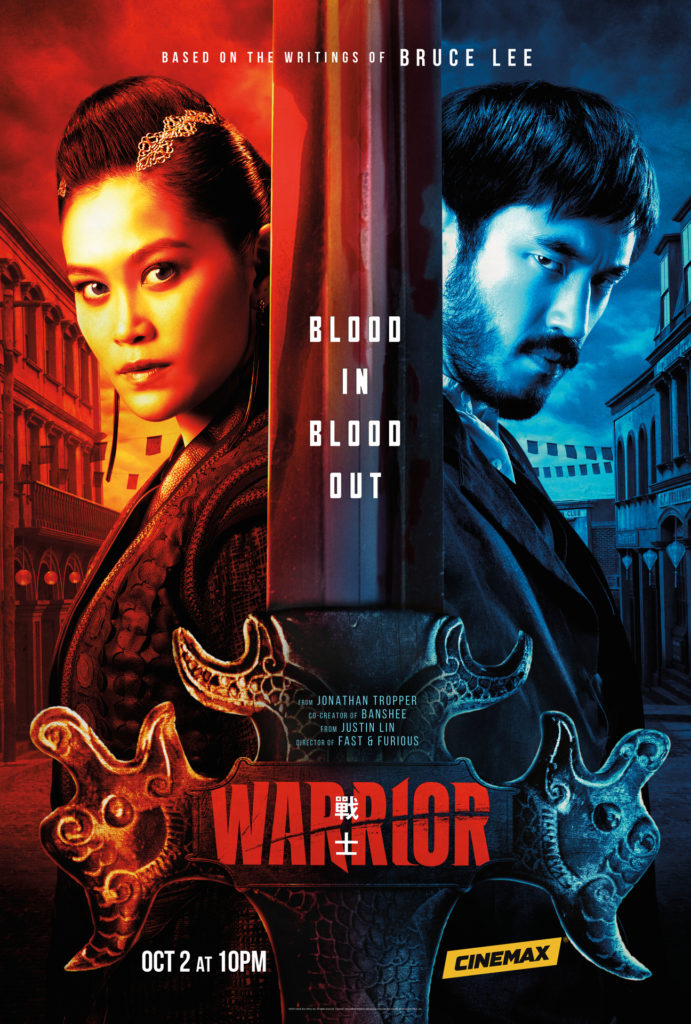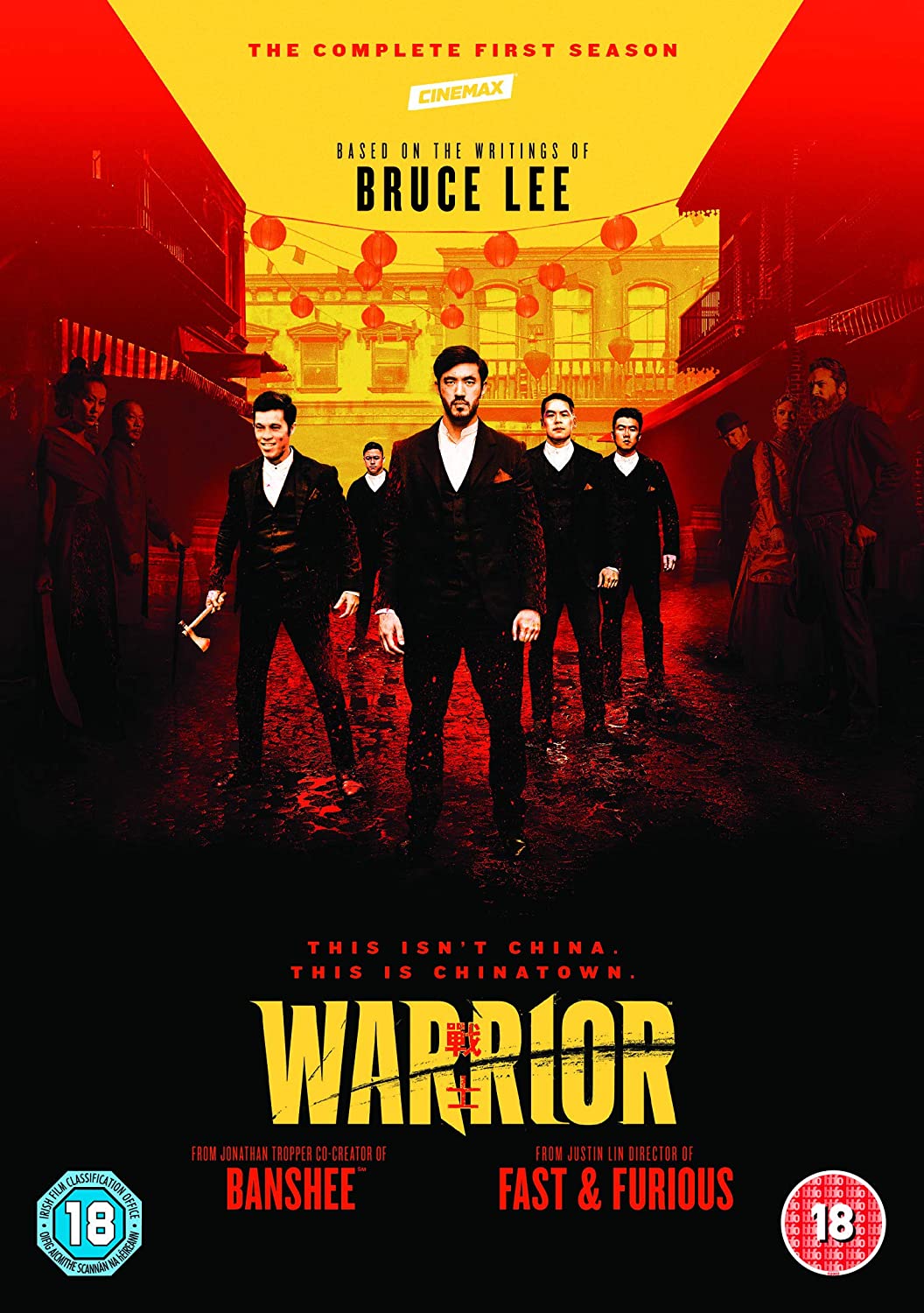“It’s Deadwood, but with Kung Fu!”
I’d bet dollars-to-donuts that was the elevator pitch for the Cinemax (now HBO Max) series ‘Warrior.’ And, if that’s enough to get you to watch it, then my work here is done. But if you need more reasons, then I’ll do my best to provide them below.
I’ll state this right off-the-bat, I’ll be going into some spoilers, but nothing that should affect your enjoyment of – or investment in – the show.
Here’s the jumping off point: Ah Sahm arrives in 1870’s San Francisco from China. When confronted with some racist dickweeds, he promptly whoops their asses with ease. This puts a damper on his plans to take a job as a “coolie” – a derogatory term for an unskilled laborer – building railroad tracks.
Fortunately for him, Wang Chao pulls him away from the ruckus with a seemingly better deal. Chao is that character you find in these types of stories who knows everyone, plays every side, and always has an exit plan in his back pocket. His exit plan for Ah Sahm, less fortunately for him, involves selling the man to the Hop Wei to serve as a “hatchet man” or enforcer.
The Hop Wei is a Tong, essentially a Chinese crime family, who are currently in the midst of navigating their way around two other Tongs in San Francisco’s Chinatown. Father Jun is the hard-ass head of the family. But his son, Young Jun, takes an immediate liking to Ah Sahm when he finds out just how well he can “Scrap.” Scrapping is fighting and, yes, some of the vernacular of the period gets a bit overplayed (especially another one that I’ll get to shortly). But that’s just a small complaint.
Young Jun is a bit restless, and has a tough time keeping his thoughts about maybe being more fit to run the Hop Wei than his father is to himself. At any rate, he promptly takes Ah Sahm to the local hot spot (i.e brothel) run by Ah Toy. At the brothel is where we learn one more, very colorful term that you’ll hear a lot – “getting sticky.” Considering where they are when you hear this euphemism, you can likely figure out what it means. Ah Sahm bonds pretty quickly with Ah Toy, who has a very cool after-hours hobby of her own that I won’t spoil here. But she earns Ah Sahm’s trust enough to learn the reason why he came to Chinatown: To find his sister.
It doesn’t take long for his to find his sister in the last place he’d expect. She’s (unofficially) running one of the other Tongs: The Long Zii. Mai Ling fled to America years before to escape an arranged marriage to an abusive warlord. A marriage she was forced into to save Ah Sahm’s life, which she is absolutely nurturing a big-time grudge over. But she’s also planning to take down the Hop Wei using group of people who might as well be gangsters: The politicians.
Mai Ling has secret meetings with Walter Buckley, who is running his own schemes alongside the fairly incompetent Mayor Samuel Blake. Blake is married to Penny, in an arrangement not unlike Mai Ling’s. Penny’s formerly wealthy father’s business has been free-falling, so she volunteered to marry the mayor in order to get a city contract to pump back up her father’s financials. The wheelings and dealings of city officials, and broke businessmen bring us back around to cheap labor, and coolies. Which, in-turn, bring us to the truest villains of the story.

The Irish laborers have fallen on hard times, and are not helped by the fact that the Chinese are willing to work for a lot less money. Coupled with the fact that the manufacturers are more-then-willing to pay as little as possible, makes for a lethal combination. There is a level of vicious racism on display here that, up until recent years, we were happy to pretend no longer existed in this country. The silver lining is that we get to watch these guys get kicked in the face pretty regularly by Ah Sahm, and others.
The exception to this is the character meant to singularly represent all this heinous bigotry, and “patriotic” fury: Dylan Leary. Leary is an undefeated bare-knuckles boxer in his spare time, though most of his free time is spent riling up anyone without earshot about the Chinese “parasites” who don’t belong in this country, and are stealing their livelihoods. This line of bullshit probably sounds all-too familiar these days, as people like Leary still exist today, and will never stop sounding the drums of a race war.
Putting the least amount of effort possible into preventing this race war, the city creates a Chinatown Squad that consists of all of five cops. Only two of these cops really matter to the story. The first is Sgt. “Big Bill” O’Hara, who’s seen more than his share of Chinatown vices. Most of which comes from his own gambling addiction that puts him in the crosshairs of the Fung Hai Tong. O’Hara is your classic used-to-be-a-good-cop who will eventually find his way into trying-to-be-a-good-cop-again territory thanks to the other pertinent member of the Chinatown Squad: Officer Richard Lee.
Officer Lee is a transplant from the south, who made his way so far from home for reasons that are addressed near the end of season 1. He’s a good deal more open-minded than pretty much any other white character on the show, besides Penny, which is a bit of a twist considering his geographic origins. He also dabbles in some shockingly modern crime scene investigation techniques. If there was one character besides Ah Sahm who could support their own show, it would probably be Lee.
Ironically, Lee was likely given his name as an homage to the man who wrote the actual original pitch for the show: Bruce Lee. ‘Warrior’ was something he tried to get off the ground back in the early-70’s, but it never happened. I expect this was due to America not being ready for a TV show with a predominantly Asian cast at the time, and Lee’s own tragic, untimely death. But his daughter Shannon Lee is a producer, and she’s brought along the creative team from another Cinemax show that featured weekly ass-beatings: ‘Banshee’
Which bring us full circle back to the Kung Fu. If that long list of characters and their relationships to one another seems a bit dense, fear not, it’s all dished out in easily digestible segments between awesome scrapping, and getting sticky. The fight choreography is as good, if not better, than anything I’ve ever seen on TV, and they give you two or three of these fight scenes every episode. I mentioned Deadwood earlier, but the way the characters speak to one another is more akin to the lighter, snappier dialogue of Justified (itself a modern western).
The title of this blog post is Going to War For ‘Warrior.’ But really, the war in this case is just to sit back, fire up your HBO Max, and plow through the first two seasons that you find there. It was recently re-located from Cinemax, and not yet renewed for a third season. I expect they’re waiting to see how many eyeballs they can get on the show before decided whether or not to renew.
So do yourself a favor, and get your eyeballs on one of the most purely entertaining TV shows that I’ve watched in years.
